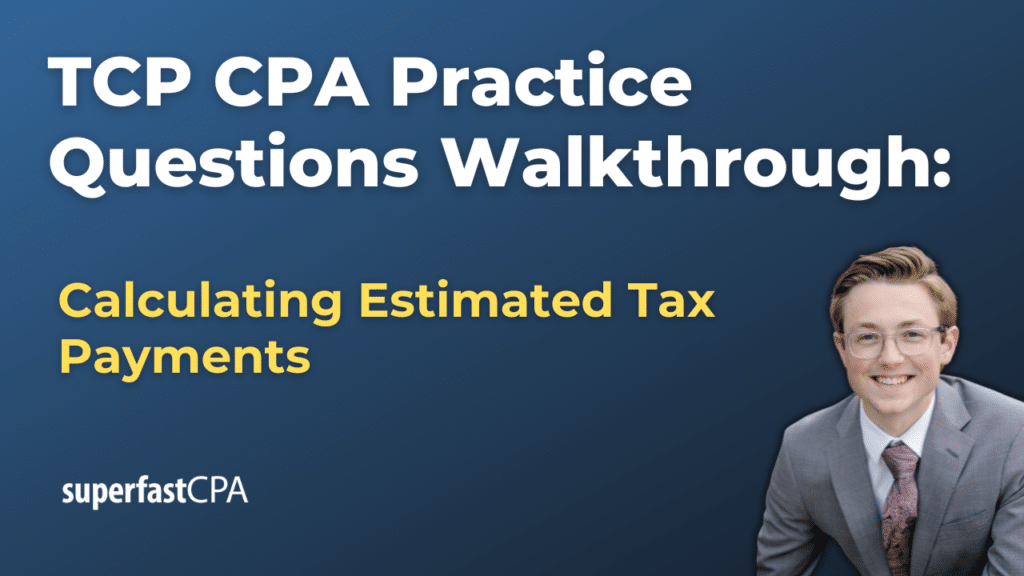In this video, we walk through 5 TCP practice questions teaching how to calculate estimated tax payments required to avoid underpayment penalties. These questions are from TCP content area 1 on the AICPA CPA exam blueprints: Tax Compliance and Planning for Individuals and Personal Financial Planning.
The best way to use this video is to pause each time we get to a new question in the video, and then make your own attempt at the question before watching us go through it.
Also be sure to watch one of our free webinars on the 6 “key ingredients” to an extremely effective & efficient CPA study process here…
Calculating Estimated Tax Payments
Estimated tax payments are periodic payments made to the IRS by individuals who earn income that is not subject to withholding taxes. This typically includes income from self-employment, interest, dividends, alimony, rent, gains from the sale of assets, prizes, and awards. Individuals may also need to make estimated tax payments if the withholding from their salary, pension, or other income does not cover their tax liability for the year.
Avoiding Underpayment Penalties
To avoid underpayment penalties, individuals must pay either:
- 90% of the tax due for the current year, or
- 100% of the tax shown on the previous year’s tax return (110% if the adjusted gross income on that return was more than $150,000, or $75,000 if married and filing separately).
These payments are generally made in four equal installments (usually April 15, June 15, September 15, and January 15). If the payments are not made on time or the amounts paid are not sufficient, the IRS may impose a penalty.
Example of Underpayment Penalty:
- Total Tax Liability for the Year: $40,000
- 90% of Current Year’s Tax Liability (required to avoid penalty): $36,000
- Total Payments Made by the Taxpayer during the Year: $30,000
- Determine the Underpayment:
- The taxpayer should have paid at least $36,000 to avoid underpayment penalties.
- The actual payment was $30,000.
- Underpayment = $36,000 – $30,000 = $6,000
- Calculate the Penalty:
- The IRS sets an interest rate for underpayment, which is currently 6%, but may change with time.
- Annual Penalty Calculation: $6,000 x 6% = $360
Summary:
- The taxpayer underpaid their estimated taxes by $6,000.
- The penalty for underpaying this amount over the year, with an annual penalty rate of 6%, is $360.
Examples of Calculating Estimated Tax Payments:
- Example for a Self-Employed Individual:
- Previous Year’s Tax Liability: $30,000
- Current Year’s Estimated Tax Liability: $35,000
- To avoid a penalty, the individual can choose to pay either:
- 90% of $35,000 = $31,500 for the year, or
- 100% of $30,000 = $30,000 for the year (assuming AGI less than $150,000 last year)
- If opting for the latter, the quarterly estimated payment would be $30,000 / 4 = $7,500.
- Example with Increased Income:
- Previous Year’s AGI: $160,000
- Previous Year’s Tax Liability: $40,000
- Current Year’s Estimated Income: $200,000
- Current Year’s Estimated Tax Liability: $52,000
- To avoid penalties, payment should be:
- 110% of $40,000 = $44,000, or
- 90% of $52,000 = $46,800
- The lesser amount is $44,000, divided by 4, so the quarterly payment would be $11,000.
- Example Insufficient Withholding:
- Salary: $90,000
- Tax Withheld: $12,000
- Freelance Income: $50,000
- Total Estimated Tax Liability: $30,000
- Last Year’s Tax Liability: $25,000
- Safe Harbor Requirement: $25,000 (100% of last year’s tax)
- Total Withheld: $12,000
- Shortfall: $25,000 – $12,000 = $13,000
- Estimated Payments Needed:`Estimated Payments Needed:
- To Avoid Penalties: Additional $13,000 needed
- Quarterly Payment: $13,000 / 4 = $3,250
What Counts as an Estimated Tax Payment?
- Withheld Taxes: Taxes withheld from wages, retirement distributions, or other sources.
- Direct Payments: Payments made directly to the IRS through estimated tax vouchers, electronic payments, or checks.
- Overpayment from Previous Years: If you had a refund due to you from a previous year and elected to apply some or all of it to your current year’s tax.
- Other Credits: Certain refundable credits, like the Earned Income Tax Credit or Additional Child Tax Credit, that exceed your tax liability may also count towards your payments.












